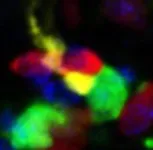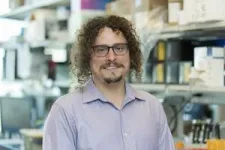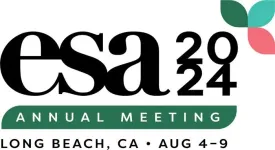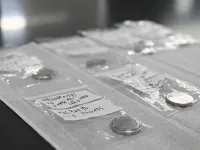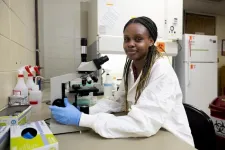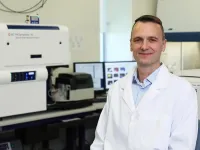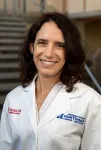(Press-News.org) There’s a frustrating fact about today’s immunotherapies for cancer. While sometimes they work beautifully — completely eliminating or greatly reducing cancer in particular patients — other times they don’t work at all. It’s a mystery.
Scientists have posed several hypotheses to explain the disparity. Perhaps it’s the number of mutations present in a tumor, with more mutations leading to better responses. Or maybe it’s the tissue environment surrounding the tumor, with some environments supporting and others suppressing effective immune responses. But so far, none of these explanations has proved definitive or applicable in all cases.
Researchers at Memorial Sloan Kettering Cancer Center (MSK) and Baylor College of Medicine in Houston, Texas, now think they have a better explanation.
“It turns out that in order for immune cells to effectively kill the cells of a tumor, they need to take on a specific spatial configuration,” says Andrea Schietinger, PhD, a tumor immunologist and member of the Immunology Program in MSK’s Sloan Kettering Institute. “They need to form a triad.”
Triad — meaning three cells. But not just any three cells will do. What you need, she explains, is three different immune cells all collaborating together at the same time and in the same spot: one dendritic cell, one cytotoxic (“killer”) T cell, and one helper T cell.
These cells aren’t rare or unusual, immunologically speaking. They’re the standard actors described in any immunology textbook. But up until now, no one knew that these cells needed to be physically present together in tumors in order to generate an effective immune response against cancer cells.
The discovery, which was published in the journal Cancer Cell on July 8, 2024, has immediate therapeutic implications and could alter the way doctors administer immunotherapies.
Seeking Clues About Why An Elite Fighting Force Fails
A postdoctoral fellow in the Schietinger lab, Gabriel Espinosa-Carrasco, PhD, is the first author on the new paper. What sparked Dr. Schietinger’s and Dr. Espinosa-Carrasco’s curiosity about this line of research was the abundant — and frankly discouraging — data from human clinical trials of adoptive T cell therapies. These are therapies in which researchers take a sample of cytotoxic T cells from a patient, identify ones that recognize the cancer, then expand those to billions of copies in the lab and return them to the patient. (Alternatively, scientists can engineer T cells in the lab to recognize specific targets and then expand and infuse those.)
The approach sounds logical; it should work, but it often doesn’t.
“How is this possible that we can generate the most perfect cytotoxic T cells in the lab, give patients billions of these cells, and yet they still fail to eliminate the cancer?” Dr. Schietinger asks. “There seems to be something so fundamental that we are missing about what cytotoxic T cells need to kill effectively.”
In retrospect, she says, the answer seems obvious.
Giving T Cells a License to Kill
Scientists have known for a long time that cytotoxic T cells don’t operate on their own. They need the assistance of helper T cells to become armed and activated. “This is textbook knowledge,” Dr. Schietinger points out.
That’s why, as she explains, every existing protocol where cytotoxic T cells are being activated and prepared for adoptive T cell therapy adds important chemicals made by helper T cells. At that point, the thinking goes, the cytotoxic T cells should be ready to fight cancer when they are infused back into the body.
But what if cytotoxic T cells need the assistance of helper T cells not only early on to become armed and activated, but also to carry out their kill mission? Do cytotoxic T cells — like James Bond — need a license to kill? Dr. Schietinger wondered.
To find out, she and her team devised a mouse model of cancer that she could treat with a form of adoptive T cell therapy similar to those currently used with people. She set up two contrasting situations. In one case, she gave the mice with cancer only cytotoxic T cells. In the other case, she gave the mice both cytotoxic T cells and helper T cells. The results were clear and dramatic: only the mice that had received both types of T cells saw their tumors regress.
“What this implies is that just having the cytotoxic machinery up and running is not really enough to do the actual killing,” Dr. Schietinger says. “You need to actually license them to kill the target cell.”
How that licensing may occur became clearer when they looked at the tumor tissues from the mice under the microscope. That’s when they saw that in the mice that had responded to the treatment, their cells had formed the distinctive immune cell triads. The cells were physically nestled together. Somehow, Dr. Schietinger says, that spatial arrangement allows cytotoxic T cells to finally get the message: time to take action.
It was an interesting and exciting finding. But would it hold beyond the particular mouse model they used?
From Mice to Humans
To answer that question, Dr. Schietinger and her team reached out to colleagues at Baylor College of Medicine, surgeons Hyun-Sung Lee, MD, PhD, and Bryan M. Burt, MD. That group had unpublished data on a group of patients with pleural mesothelioma, a type of lung cancer, who had been treated with a form of immunotherapy called immune checkpoint blockade. Within that group, some of the patients had responded well to the treatment, seeing their tumors shrink, while others did not.
When the surgeons at Baylor went back to look at tissue samples they had collected as part of the trial, they found that those patients who had responded to the therapy had the distinctive triads in their tumors. The ones who didn’t respond did not have them.
That was pretty compelling evidence that the immune triads were indeed important, and not just a coincidence. The three types of immune cells interact in such a way that makes them a stronger fighting force against cancer cells.
Clinical Implications of Immune Cell Triads
What are the implications of all this? First, says Dr. Schietinger, there is the possibility that these triads could be used as a biomarker for identifying which individuals are likely to respond to immunotherapy. So far, doctors do not have good biomarkers to make that distinction.
Second, the results imply that doctors should rethink how they administer adoptive T cell therapies. Instead of giving predominantly killer T cells, perhaps they should include helper T cells too; and maybe much fewer killer T cells would be enough if there were helper T cells in the mix as well.
Lastly, the results have implications for the design of cancer vaccines, where fragments of cancer-associated proteins are designed to boost patients’ killer T cells.
Dr. Schietinger’s team is working to advance research in all these directions. For example, one member of her team, a bioengineer, is designing tools to connect one killer T cell to one helper T cell, to encourage their formation of a triad with a dendritic cell (the cell type responsible for presenting fragments of cancer proteins to T cells).
They’re also experimenting with new formulations of cancer vaccines and are partnering with other leaders in the field to bring this work to clinical trials.
“The main implication of our findings is that it’s not the absolute numbers of cells that matters, it’s their spatial configuration,” Dr. Schietinger says. “The three cell types need to be on the battlefield together, and building therapeutics which do that is our next big goal.”
Additional Authors, Funding, and Disclosures
Additional authors on the study include: Edison Chiu and Asim Dave of MSK; Matthew Hellmann of MSK and Weill Cornell College of Medicine (now at AstraZeneca); Aurora Scrivo of the Albert Einstein College of Medicine; Paul Zumbo and Doron Betel of Weill Cornell Medicine; and Sung Wook Kang and Hee-Jin Jang of Baylor College of Medicine.
This work was supported by NIH grants DP2CA225212 and R01CA269733, a Lloyd Old STAR Award of the Cancer Research Institute, an AACR-Bristol-Myers Squibb Midcareer Female Investigator Award, the Pershing Square Sohn Award, the Josie Robertson Young Investigator Award, the Weill Cornell Medicine Core Laboratories Center, a Ludwig Cancer Center Postdoctoral Fellowship, NIH Merit Award R37CA248478, Cancer Prevention and Research Institute of Texas Grant CPRIT RP200443, Department of Defense Peer Reviewed Cancer Impact Award CA210522, NIH R21AI159379, the Helis Medical Research Foundation, the Cytometry and Cell Sorting Core at Baylor College of Medicine with funding from the NIH (NCI P30CA125123 and NCRR S10RR024574) and CPRIT (RP180672), the MSKCC-Integrated Genomics Operation Core, funded by the NCI Cancer Center Support Grant (P30 CA08748), Cycle for Survival, and the Marie-Josée and Henry R. Kravis Center for Molecular Oncology.
Dr. Hellmann is currently an employee and shareholder at AstraZeneca. Dr. Burt received funding from AstaZeneca for the clinical trial related to this project, clinical trial funding from Momatero-Gene, and clinical trial funding from Novartis.
Read the study: “Intratumoral immune triads are required for immunotherapy-mediated elimination of solid tumors,” Cancer Cell. DOI: 10.1016/j.ccell.2024.05.025
END
Better together: spatial arrangement of three immune cells is key to attacking tumors
2024-07-15
ELSE PRESS RELEASES FROM THIS DATE:
How a ‘social good’ firm is defined can impact its value creation and value capital
2024-07-15
Ventures that pursue both commercial and social value creation have grown in popularity in recent years, but a new study published in the Strategic Entrepreneurship Journal better defines four distinct types of social ventures. By training a business model lens on these social good ventures, the study offers insight on how the model choices impact a firm's value creation and value capture potential.
“Despite the popularity of the term ‘social entrepreneurship,’ not much was known about the business model of such companies yet,” says study co-author Lien De Cuyper of ...
American diets got briefly healthier, more diverse during COVID-19 pandemic
2024-07-15
UNIVERSITY PARK, Pa. — American diets may have gotten healthier and more diverse in the months following the start of the COVID-19 pandemic, according to a new study led by Penn State researchers.
The study — published in PLOS ONE — found that as states responded to the pandemic with school closures and other lockdown measures, citizens’ diet quality improved by up to 8.5% and food diversity improved by up to 2.6%.
Co-author Edward Jaenicke, professor of agricultural economics in the College ...
Media Tip Sheet: Symposia at ESA2024
2024-07-15
The latest ecological research will be on full display at the Ecological Society of America’s upcoming Annual Meeting in Long Beach, California, Aug. 4–9. A focal point of the conference, symposia consist of four 20-minute talks organized around a central theme of broad interest. These sessions consider topics from different angles, integrate multiple lines of evidence and offer new insights on ecological phenomena.
This year, Annual Meeting symposia will address nonmaterial (“cultural”) ecosystem services, nature-based solutions to problems like stormwater runoff and urban heat, ...
Making rechargeable batteries more sustainable with fully recyclable components
2024-07-15
UNIVERSITY PARK, Pa. — Rechargeable solid-state lithium batteries are an emerging technology that could someday power cell phones and laptops for days with a single charge. Offering significantly enhanced energy density, they are a safer alternative to the flammable lithium-ion batteries currently used in consumer electronics — but they are not environmentally friendly. Current recycling methods focus on the limited recovery of metals contained within the cathodes, while everything else goes to waste.
A team of Penn State researchers may have solved this issue. Led by Enrique Gomez, interim associate dean for equity and inclusion and professor of chemical engineering ...
Biodegradable electronics may advance with ability to control dissolve rate
2024-07-15
UNIVERSITY PARK, Pa. — Biodegradable electronics allow for medical devices — such as drug delivery systems, pacemakers or neural implants — to safely degrade into materials that are absorbed by the body after they are no longer needed. But if the water-soluble devices degrade too quickly, they cannot accomplish their purpose. Now, researchers have developed the ability to control the dissolve rate of these biodegradable electronics by experimenting with dissolvable elements, like inorganic fillers and polymers, that encapsulate the device.
The team, led by Huanyu “Larry” Cheng, the James L. Henderson, Jr. Memorial Associate Professor ...
Most Salmonella illnesses from chicken caused by few products with high levels of virulent strains
2024-07-15
URBANA, Ill. – Raw poultry is one of the main causes of Salmonella poisoning, which affects thousands of people in the U.S. every year. A new study from the University of Illinois Urbana-Champaign shows that few products with high levels of very virulent Salmonella strains are responsible for most of the illnesses from raw chicken parts. The researchers suggest regulation efforts should focus on detecting and preventing those types of high-risk contamination.
“Over the last 20 years, the poultry industry has done a really good job of lowering the frequency of Salmonella in poultry. However, the number of people ...
Kenyan crop contamination outbreak inspires grad student to improve rice storage
2024-07-15
By Maddie Johnson
University of Arkansas System Division of Agriculture
Arkansas Agricultural Experiment Station
FAYETTEVILLE, Ark. — While half the global population relies on rice as a staple, about 15 percent of rice produced each year is contaminated by potentially fatal aflatoxins. Seeing this threaten lives in her home country of Kenya prompted a graduate research assistant to focus on eradicating the risk through safer storage methods.
Faith Ouma, a Ph.D. student in the food science department at the University of Arkansas, was the lead author of “Investigating safe storage conditions to mitigate aflatoxin contamination in rice.” It was published ...
Survey finds women in their 40s may choose to delay mammography when informed about the benefits and harms
2024-07-15
Embargoed for release until 5:00 p.m. ET on Monday 15 July 2024
Annals of Internal Medicine Tip Sheet
@Annalsofim
Below please find summaries of new articles that will be published in the next issue of Annals of Internal Medicine. The summaries are not intended to substitute for the full articles as a source of information. This information is under strict embargo and by taking it into possession, media representatives are committing to the terms of the embargo not only on their own behalf, but also on behalf of the organization they represent.
----------------------------
1. ...
CDI scientists ID ‘unconventional’ new pathway for TB vaccines
2024-07-15
An “unconventional” immune response now identified by scientists from the Hackensack Meridian Center for Discovery and Innovation (CDI) is a potential new pathway for developing new vaccines for tuberculosis (TB), according to a new publication.
Marginal zone B (MZB) cells are a natural response to TB infection which has been long overlooked - and which might be a welcome new target that could be bolstered through new vaccines to better combat and prevent the disease, according to the new publication in the journal Cell Reports.
“Our results indicate that B cells skew their immune landscape ...
Mendoza, Weiss receive $2.6 million grant to study biomechanics of lung tumors
2024-07-15
Michelle Mendoza, PhD, researcher at Huntsman Cancer Institute and associate professor of oncological sciences at the University of Utah (the U) and Jeffrey Weiss, PhD, professor of biomedical engineering and faculty member in the Scientific Computing and Imaging Institute at the U, are the recipients of a $2.6 million grant from the National Institutes of Health (NIH) to research how tension in lung tissue affects the growth and distribution of tumors. This innovative approach could uncover new mechanisms for understanding how lung cancer develops.
“There ...
